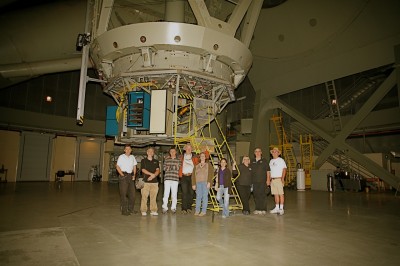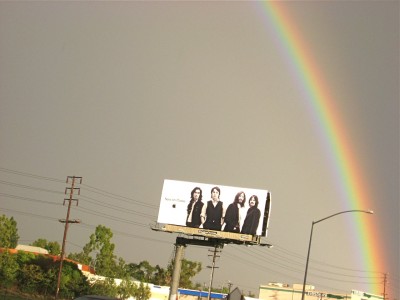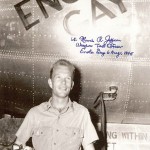Jamesetta Hawkins, born January 25, 1938 in Los Angeles to a teenage prostitute, never knew her father and grew up in various foster homes. She became a major recording and performance artist under the name “Etta James”. She passed away on January 20, 2012 in Riverside, California.
Category Archives: California
Visiting Mount Palomar
Last weekend I was part of a group making a visit to the Mount Palomar Observatory.
When I was in school (voraciously sucking up astronomy books), Mount Palomar seemed to me like a place of magic and wonder. From its opening in 1949, and until 1992/93, the giant 5.1 m (200 inch) Hale Telescope was the largest and most important telescope in the world. (Actually, there was a larger Soviet telescope of a later design, but it is often omitted because it never functioned quite well).
The compound on the Southern California mountaintop also encompasses several smaller telescopes. Together, they account for most of the groundbreaking discoveries in the entire history of astronomy.
Here are some pictures. (Click to enlarge).
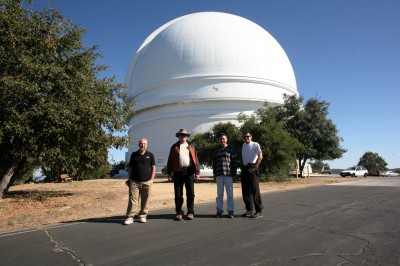
In front of the Hale Telescope dome, Mount Palomar. From left to right: Jed Laderman, Dave Yantis, Robert Lozano, Reinhard Kargl.
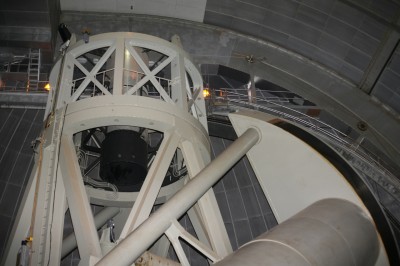
Looking up to the secondary mirror, toward the top of the dome. In the old days, this is where the observer would have sat in a cage all night long, handling photographic materials. Today, the instruments are photo-electronic. Human observers no longer ride the elevator to the top).

The old control panel, preserved in a perfect vintage look. Doesn't it seem like something from Star Trek? (Today, the telescope operator sits in a heated cabin, insulated from the dome interior. This being on a mountain top, it gets extremely cold in the winter).
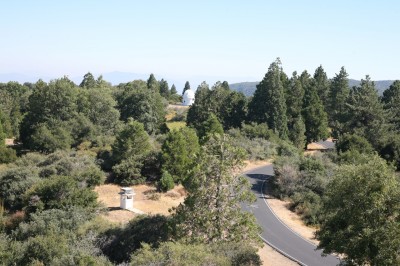
View from the Hale dome's circular catwalk. In the distance is the dome of the historic 18 inch Schmidt telescope. Beginning in the 1930s, Fritz Zwicky did his first surveys of supernovae here. The dome is no longer in use today.
More on Fritz Zwicky and the 18 inch Schmidt telescope.
Today’s Rocket Launch
Today’s launch of a huge Delta IV Heavy lifted an NRO reconnaissance satellite into orbit. (Mission NRO-49). This was probably the largest rocket ever to launch from California so far. Here’s a picture I took from my window:
Why We Must Hire Robots, Not Minimum Wage Workers
I encourage you to watch the following video entirely before allowing me to present my point of view:
As you can see, almost the entire manufacturing process in this film is handled by sophisticated machinery: robots.
I have long argued that instead of exploiting cheap Third World labor and lenient environmental regulations abroad, and instead of importing low wage workers en masse, the European Union and North America should focus on developing robotic manufacturing techniques for all consumer goods. Japan, unwilling to open its borders to foreign workers, is making great strides in this direction and will probably dominate the robotics industry, which it expects to see huge growth over the next few decades.
Robots could free mankind from the burden of most cumbersome, dangerous and boring toils. This would permit a restructuring of society to grant each individual more time for intellectual pursuits and pleasure. This in turn will fuel the education, media, travel and entertainment sectors of our economy, all of which are extremely difficult to outsource to cheap-labor countries.
Double Rainbow
This week, Southern California was drenched by record-breaking rainfalls, resulting in the usual traffic chaos, power outages, floodings, mudslides and other theatrics for which the area is notorious.
But there were also moments of beauty. I snapped these pictures from a moving car while traveling south on the 405 Freeway. The entire arch of the double rainbow was visible, but it didn’t fit into the frame.
Somehow I think John Lennon, who was killed 30 years ago, would have loved these images. (Click to enlarge).
Crossing The Bridge to Nowhere
Trekking up and down the East Fork of the San Gabriel River last weekend, through intense heat and about 20 wildwater crossings, we found the mysterious Bridge to Nowhere.
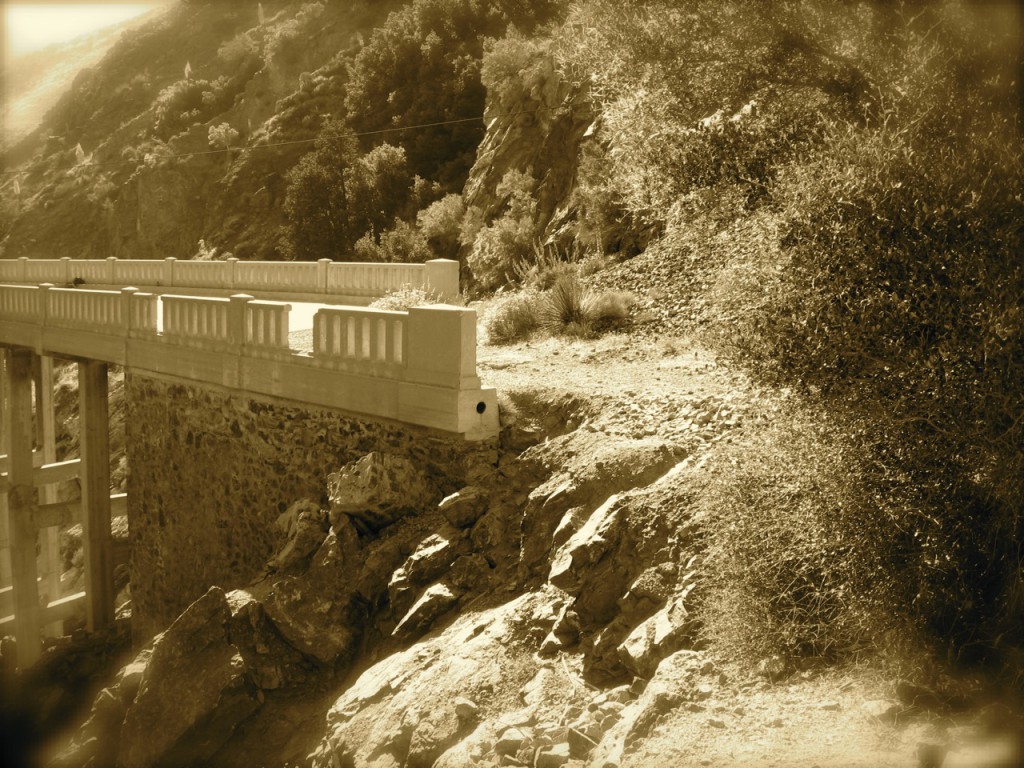
Bridge to Nowhere. Sheep Mountain Wilderness, California. 34°16′59″N 117°44′48″W. Click to enlarge. Photo: Reinhard Kargl, 2010
Why is there a bridge in the middle of the wilderness?
I was wondering too.
Built in the San Gabriel Mountains in 1936, the 120 ft (27 m) high bridge was supposed to be part of a road connecting the San Gabriel Valley in Los Angeles County with Wrightwood in San Bernardino County. But the road was never completed.
After being overcome by a flood in March of 1938, the road construction project was abandoned.
The bridge remains, leading nowhere. It is accessible only on foot.
Enola Gay Weapons Specialist Dies
The story of mankind’s first use of nuclear weapons in war has always fascinated me.
Who were the men who designed and built these weapons? And who were the men who delivered it? How did they personally justify, cope and live with the unspeakable destruction of civilian life, including women and children, caused by their actions?
One by one, the people involved in these events are passing away. With the death of Weapons Specialist Morris “Dick” Jeppson on March 30, at the age of 87, there is only one person from the Enola Gay crew still alive today: Navigator Theodore “Dutch” Van Kirk, who is 89 this year.
On August 6, 1945, it was Jeppson’s job, along with Navy Capt. William “Deak” Parsons, to arm the bomb that ended up destroying Hiroshima, and killing somewhere between 90,000 and 160,000 people within months. (Many others died from wounds and from the effects of radioactive contamination in decades to come).
After the war, Jeppson studied toward a doctorate in physics at UC Berkeley. He working at Berkeley’s radiation laboratory and the Lawrence Livermore laboratory, both here in California.
He also founded a number of companies, including Applied Radiation Corp., which built electron-beam accelerators for nuclear physics research, and Cryodry Corp., a maker of industrial microwave ovens.
Jeppson lived in Carmel, California, and retired to Las Vegas 20 years ago. He did not speak about the bombing in public until 1995, and even then, his comments were laconic: “You had a job to do, you just did it.”
Long Live The Flying Saucer!
Some inventions fly all over the planet. One such thing is the Frisbee, whose inventor, Walter Fredrick Morrison passed away at the age of 90 last week.
Since the 1950s, hundreds of millions of people (and their dogs) have been enjoying the flying discs. The original mass manufacturer, the American toy company Wham-O Inc., has sold more than 200 million of them. In addition, there must have been hundreds of millions of knockoffs made all over the world.
I grew up in Europe. My personal introduction to the Frisbee arrived with Kirk, an American exchange student from Ohio, who stayed with us at my parents’ house. To me as a boy, Kirk seemed very cool and very mature.
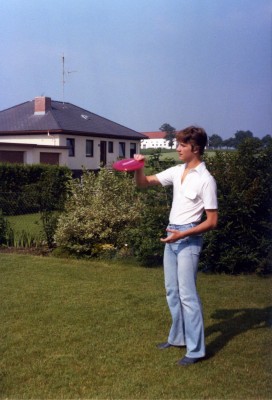
Childhood memories: Kirk in my parents' backyard, demonstrating proper Frisbee technique. It's all in the wrist!
Inventor Fredrick Morrison’s family moved from Utah to California when Fred was 11 years old. In 1937, he and his girlfriend Lucile began tossing a large popcorn lid back and forth. It seemed like a fun thing to do at a Thanksgiving party. The fun soon continued at Santa Monica Beach, where the couple switched to tossing a cake pan.
Californians are always quick to pick up a trend. When another beach-goer offered Morrison a quarter for the cake pan, it dawned on him that he had a business. (A cake pan cost just a nickel, thus allowing a hefty margin). Soon, Morrison and his girlfriend were selling cake pans at the beach.
They married in 1939. Soon afterwards, Morrison was off to the war. He served in the Army Air Force as a P-47 Thunderbolt pilot in Europe, was shot down and spent 48 days as prisoner of war.
Back home in 1946, Morrison used his aviator’s knowledge to sketch a more aerodynamical disc, which he called the Whirlo-Way. With experiments and experience, the discs’ shape was further improved and resulted in the Pluto Platter of 1955. Two years later, Morrison sold the patent to Wham-O Inc., also known for the Hula-Hoop a dozen other wacky toys. It was Wham-O that came up with the name “Frisbee” – which Morrison first resented but then (after receiving more than $2 million in royalties) made peace with.
And that’s the story!
I’m not sure what happened to Kirk after he left. But the Frisbee he gave me, made from indestructible plastic, might still be found in my parents’ basement somewhere.
_______________________________________________________
![]()

